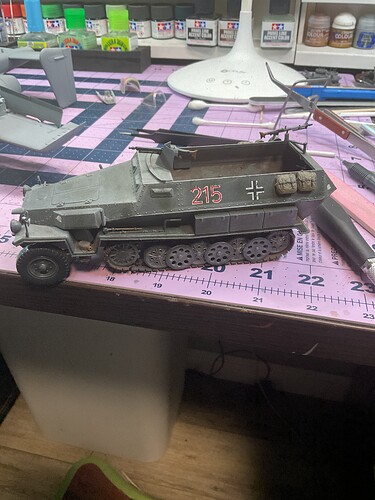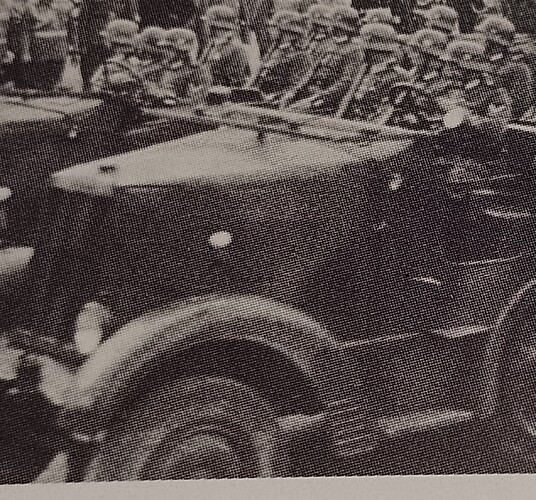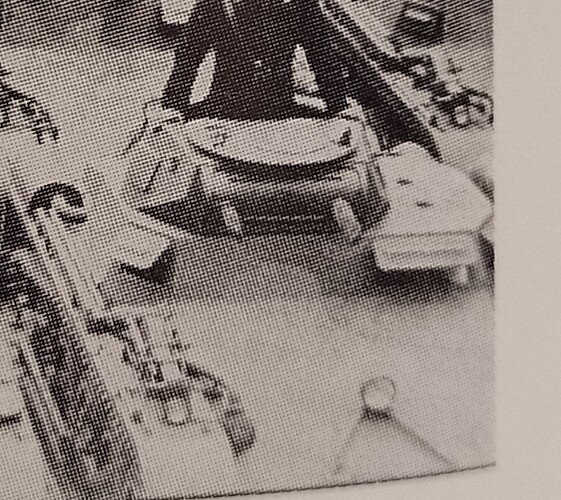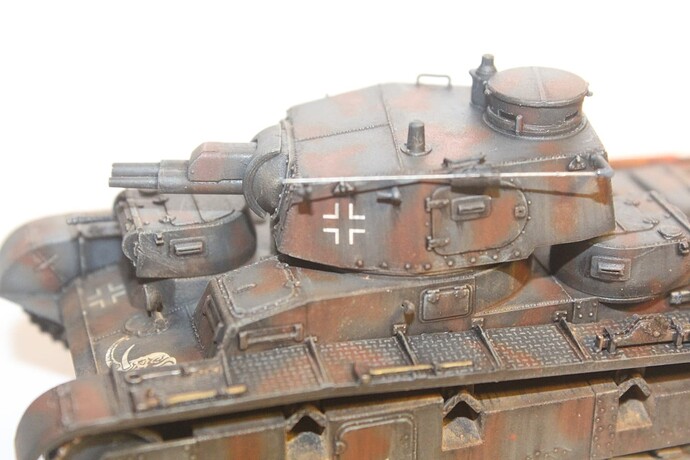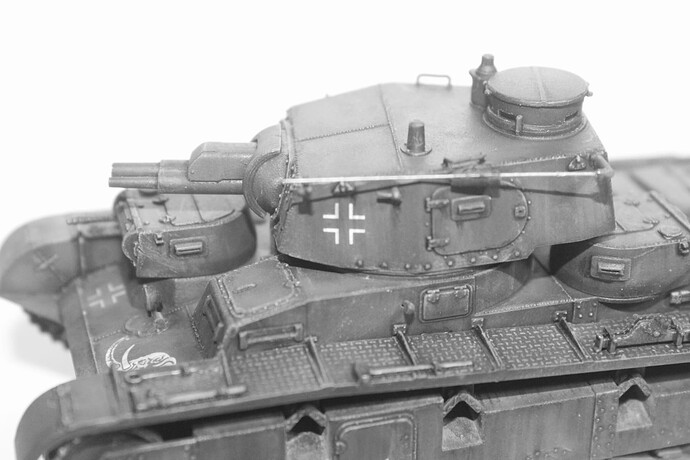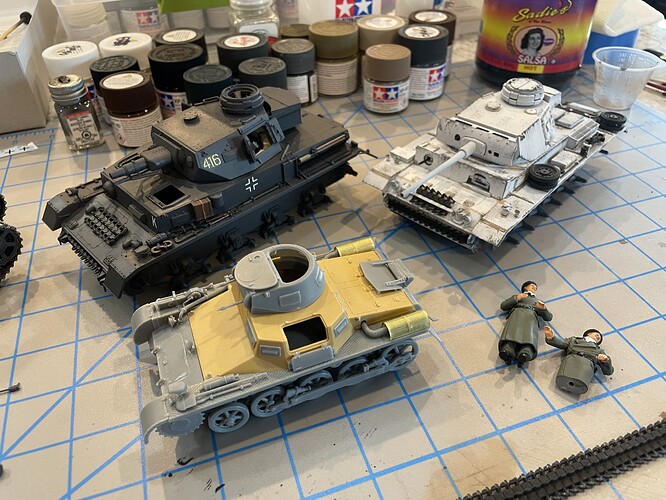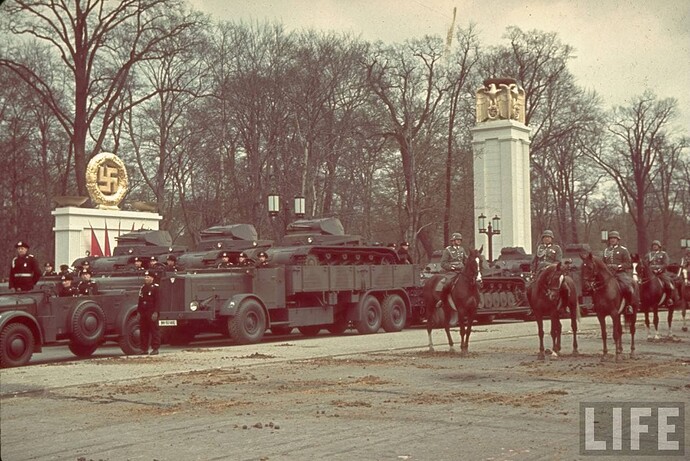Is there any evidence to suggest that German halftracks, and soft skins had brown patches over the Pz gray base color during the Polish Campaign? Since brown and gray are tonally similar, they are virtually indistinguishable in B/W photos. But brown is known to have been used as a secondary color on tanks until after the French Campaign; were other armored vehicles similarly painted?
![]()
![]()
Really hard to say. These photos are from the German victory parade after the Polish campaign. You can sort of see a secondary color on the towing vehicles here
and here something looks to be there
definitely a secondary color visible on these transporter trucks
As far as I know, all army heavy equipment shared the same regulations for camouflage so I think it had brown as well.
Thanks. Looks like there was no standard pattern. If those Life Magazine colors are really correct, then that Pz Gray definitely has a greenish cast, and looks more like a Field Gray.
![]()
![]()
I’d go towards leaning that it’s an Olivegrun vs Rotbraun as those examples I’ve seen at least on some color plates in various books but then again those were subjective guesses from b n w photos. I’ve done a sdkfz 251/1 that way and the contrast it gave was similar to those pictures.
The Time/Life Magazine pics above must suffer from either a color shift due to them (not likely!), or due to being scanned (how many times?) (more likely!). It has never been noted that base color Pz Gray was ever replaced with another color, except for secondary camo color brown. And no hobby paint manufacturer has ever suggested that there was green in the Pz Gray (Gasp!!!) ![]() . Must just be due to scanning and rescanning the images.
. Must just be due to scanning and rescanning the images.
![]()
![]()
Different Inspectorates were responsible for Armour and general service vehicles. Inspectorate 2 was primarily responsible for the Army in the pre-war years. In July 1937 they directed that Tanks and other armoured vehicles be painted 2/3 in RAL 7021 Dunkelgrau No 46 and 1/3 RAL 7017 Dunkelbraun No 45 which was to cover the previous multi colour schemes used.
Non-armoured vehicles were to be painted Dunkelgrau.
The Inspectorate responsible for motor vehicle deliveries (Inspectorate 6) issued a directive on 20 January 1939 citing a change and how general vehicles were to painted:
In the case of motorcycles and cars used for unit level staff and specialised service units, they were to remain RAL 7021 Dunkelgrau No 46.
All other ‘soft skinned’ vehicles (Multi-axel trucks and their Trailers, etc) were to be painted 2/3 in RAL 7021 Dunkelgrau No 46 and 1/3 RAL 7017 Dunkelbraun No 45, as per the previously provided colour card 840 B2 issued with directions in May 1938.
These were the colours applicable during the Invasion of Poland.
On BW photos from 1936-38 its possible to distinguish camouflage patterns. The lack of these on most pictures from 1939 suggest that they were not camouflaged. It has been proven by pictures that the 251s of the 1. Panzer Division delivered shortly before the start of the war were Panzergrau only, which suggests that also other 251s were delivered in the same way.
I completely agree with Peter and Leo above, only rational options are dunkelgrau with or without Dunkelbraun.
Although you can never say never, I think that so early in the war it would be quite unlikely to find exotic variants with Feldgrau, not to say Olivegrün .
If I remember correctly, Polizei vehicles in occupied zones were painted in a grey-green, but that is a different subject.
The pre-war vehicles were painted in a 3-color scheme - the yellow was high contrast and is easily distinguishable from the other colors. Even in B/W the different colors are distinctive. However, even though brown is distinguishable from gray, in B/W they become tonally inseparable. A good example is the Nb Fz Pz lV’s in Norway, 1940. They have 2-tone camo, but appear to be only gray. Just because you see a tank which looks overall gray (in 1939 - 1940) doesn’t mean it is. Even the caption, and the editor, could be wrong, especially if it is an older publication.
Here’s an interesting illustration:
The Nb Fz. Pz. lV in color:
Now the same vehicle (and same pic) in B/W:
The brown. in the B/W, where noticeable, looks like a dirty, or dusty area. It’s pictures like these in publications that can be very misleading.
![]()
![]() .
.
I recently dug out some German tanks I built a year or two ago, now seeing this post I dug out an old Tristar Panzer I. My question is, what Tamiya brown would be a good match for the grey and brown pattern you guys are all talking about? I don’t do a lot of German stuff, so I’m really not familiar with proper colors. Thanks guys
The simple switch from color to black and white of a digital photo by a computer does not get the same look as actual film black and white photography. Films have certain characteristics such as being red or blue sensitive. Also, professional photographers can add filters to their lenses that will alter, enhance, or reduce, that appearance and contrasts even more. It’s similar to looking at out doors with your eyes, then putting on some bronze or amber tinted glasses. Some colors and contrasts are enhanced, while others are toned down.
Also due to the fact that early color film was not the most stable medium; both fading and color shifts from long storage and/or storage under hostile conditions are two of the eternal problems with trying to match colors to period color photographs.
No, Feldgrau was only for uniforms and equipment, not for vehicles (at least Wehrmacht tanks, trucks, etc.).
The correct one is Dunkelgrau, RAL 7021
As stated above, early colour pictures rarely show the true colours due to the effect of time. Photos I took that were great in the 1970’s now look 50 shades of pink!
This image above clearly demonstrates the red levels are dominating - the shadows are a red-pink. Reducing the red content starts to improve the appearance, but then the green and blue starts to over power:
So trusting colour photos will never be ideal.
As Carlos says, digitally shifting a colour picture to a B&W scale also is not the same as taking a B&W picture. B&W photos taken close to the vehicle may show the two tones better, but from any usual distance, and with the quality of the film and the photographer’s skill varying, most often you cannot see any variations.
Then whilst the vehicles in the above pics are parade vehicles, like the majority of photos you see there are layers of road dust and grime on them which masks the colours and demarcation between them under the layers. If these were B&W, the likelihood is that they would all appear a monotone colour.
It depends on how you intend to finish it James. Too many people get hung up on the perfect colour match for their model. Then they add a light grey or black primer, which in itself effects the tone of the actual base colour used - unless you add lots of paint over the primer. Then over that they add filters, washes, oil dot fading, etc, all which change the base colour more anyway.
If you want straight out of the jar, then I suggest XF 63 German Grey and XF-10 Flat Brown as the closest options. Myself, I add a little black to them to make them a little darker, then do a light ‘mist coat’ of the straight colour to give a slight variation in tones.
Once you start weathering, fading, and dirtying your vehicles, the discussion of “perfect colors” goes right out the window! ![]()
![]()
![]()
![]()
I was going to address that point myself; I took the photo’s with a digital camera, at high resolution, in optimal conditions (my “studio”). Most war-time photo’s were taken in a rush (no posing), in less than optimal conditions, and on grainy film. My examples do show a slight hint of two colors; an 80-something yr. old faded negative - not so much.
![]()
![]()
Thanks, got the German grey, and I have all of Tamiyas browns, so I’ll give the plain brown a try. But I also agree with the other comments, once you start weathering it all goes out the window! Lol
